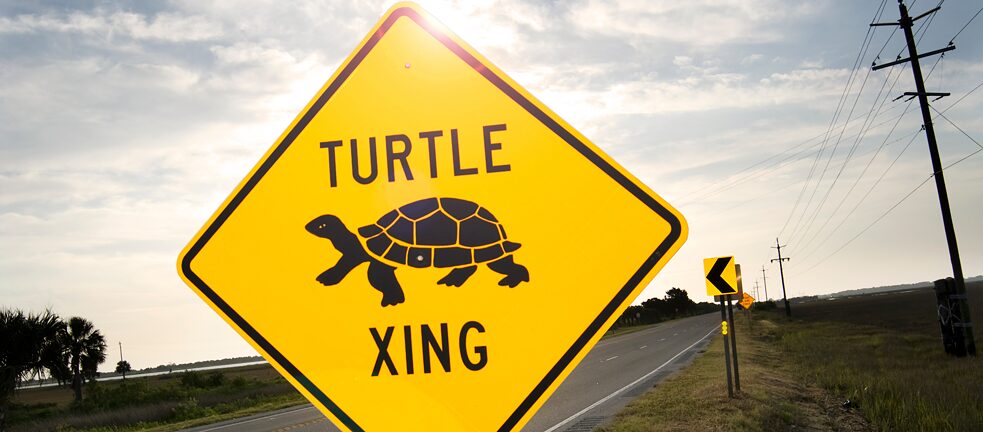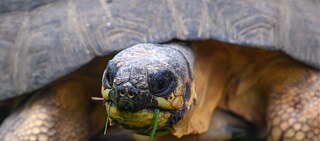There are 335 species of turtle and tortoise, but many of them are at risk of extinction. A German association focuses on the worldwide conservation of the last of the dinosaurs.
It was love at first sight: As a small boy, Mario Herz often stood agog at the window display of the local pet shop, fascinated by the turtles in the store. After much begging and pleading, his mother finally gave in. “It was my greatest wish of all,” he remembered. After all, the love of small animals was already a family tradition, his father being an aquarist.
That one turtle and his childish interest evolved into a hobby, still his passion in his mid-50s. Herz is chairman of the association Schildkröten AG (Tortoise Association), a sub-group of the Deutsche Gesellschaft für Herpetologie und Terrarienkunde e.V. (German Society for Herpetology and Herpetoculture, DGHT). For 50 years, around 600 members of the association have been involved in the conservation of tortoise and turtle species, also on an international scale. The group was founded in the former GDR. After the reunification of the two German states in 1990, it expanded to cover the entirety of Germany – after all, there were turtle fans in the West, too.
Yet, only the European pond terrapin lives in the wild in Germany. Although an invasive species is now spreading in the country, in the form of the slider turtle. “They are bigger than the pond terrapin and compete for the same habitat,” explains Herz. Admittedly, some owners of nonnative species release their animals into the wild, but their chances of survival are generally low. “They don’t cope well with the harsh winters.”
Rescue Campaign in Madagascar
Herz should know because his pond at home now has 80 of these little reptiles swimming and walking around. Their diversity is considerable: There are 335 species around the globe, but many of those are at risk of extinction. That’s why Schildkröten AG is involved in international projects for their protection.
In Madagascar, in April 2018, for example, more than 10,000 endangered radiated tortoises were seized by the Madagascan authorities at a small house on the country’s southwest coast. The tortoises were destined for sale as an illegal delicacy or pets on the Far Eastern market. They were vegetating in their own excrement and had no access to fresh air, food, water, or sunlight. Thousands of them were more dead than alive, hundreds had died already. The Germans took care of the animals with the help of the Arbeitsgemeinschaft Artenschutz (Association for Species Conservation). Most of the rescued radiated tortoises were rehomed in the Lavavolo animal shelter near Itampolo. The tortoises now get a second chance at life in the wild. Their reintroduction is currently in the planning stage.
 Caution: Turtle Crossing! A road sign in Georgia, U.S.
| Photo (detail): © Adobe
Schildkröten AG also supports species conservation projects in the U.S., Japan, China, and Vietnam. “It’s an international community,” explains Herz, who is ecstatic about the global network of reptile supporters. A number of scientists are also active in the group. For example, they compile studies on the genetic viability of turtles and tortoises, working in line with the Washington Convention for species conservation. The “Convention on International Trade In Endangered Species of Wild Fauna and Flora” (CITES) aims to establish sustainable international trade involving endangered species. The breeding statistics collected since 1979 by members of DGHT AG Schildkröten are a useful resource, the only one of its kind in the world. The data gathered helps them assess whether a species can reproduce effectively in captivity.
Caution: Turtle Crossing! A road sign in Georgia, U.S.
| Photo (detail): © Adobe
Schildkröten AG also supports species conservation projects in the U.S., Japan, China, and Vietnam. “It’s an international community,” explains Herz, who is ecstatic about the global network of reptile supporters. A number of scientists are also active in the group. For example, they compile studies on the genetic viability of turtles and tortoises, working in line with the Washington Convention for species conservation. The “Convention on International Trade In Endangered Species of Wild Fauna and Flora” (CITES) aims to establish sustainable international trade involving endangered species. The breeding statistics collected since 1979 by members of DGHT AG Schildkröten are a useful resource, the only one of its kind in the world. The data gathered helps them assess whether a species can reproduce effectively in captivity.
Ancient Masters of Survival
Individual members also contribute to maintaining biodiversity, such as Stefan Merz from the Swabian city of Reutlingen whose Seychelle giant tortoise breeding program was a success. Further support comes from zoos. For example, they bred Vietnamese pond turtles in Münster, which are now preparing for release into the wild in their natural habitat. To achieve this, the size of the enclosure gradually increases until it constitutes an appropriate space for the species to move freely.
For a comparatively small organization, Schildkröten AG is quite influential on a global scale. “We’re a fringe group,” admits Herz nevertheless, “each and every one of us is a species conservationist.” Herz is still fascinated by the reptiles 50 years later. “I just think they’re beautiful, these ancient, armored creatures,” he says, “After all, they are dinosaurs.” In fact, research has shown that the two probably are related. At any rate, tortoises and turtles are masters of survival: They have existed for more than 200 million years and remain almost unchanged.
09/2023
